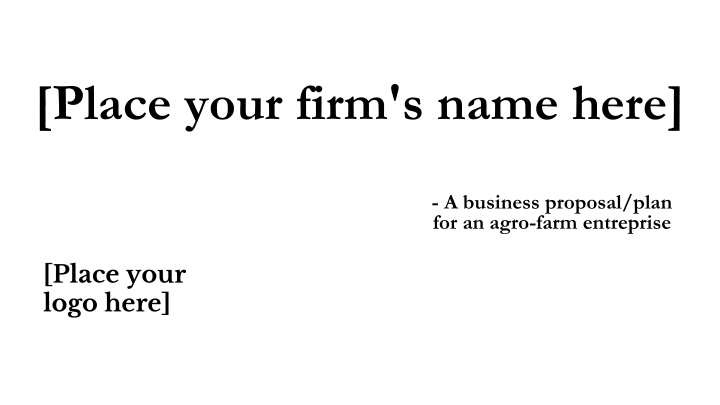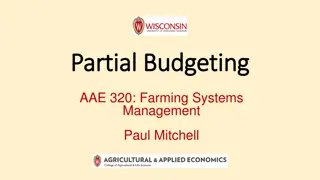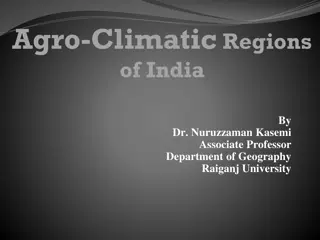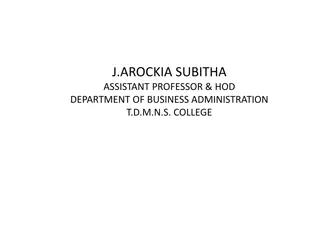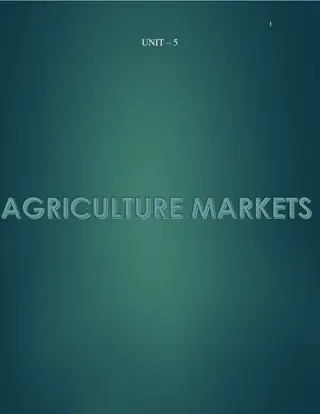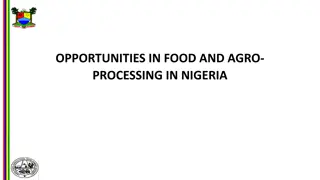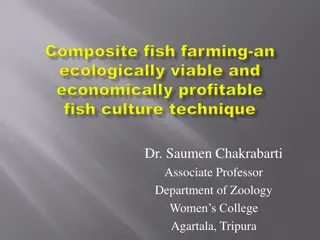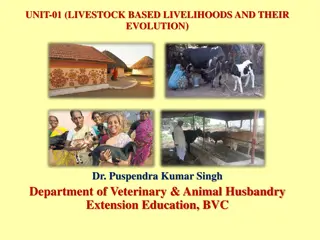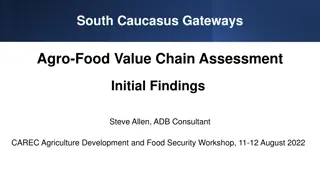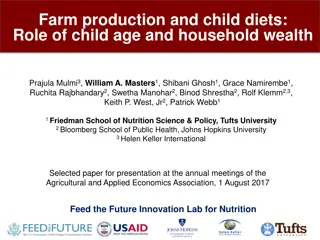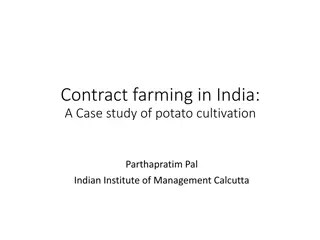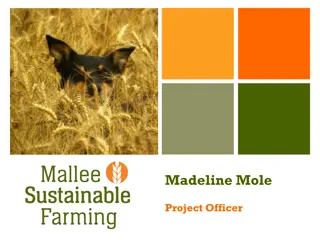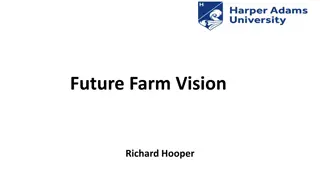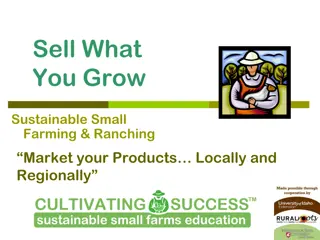Innovative Agro-Farm Business Proposal for Sustainable Farming
Conceive and run large-scale agricultural projects employing cutting-edge technologies in farming operations and management. Our vision is to promote fairness, excellence, harmony, and sustainability while engaging in sustainable commercial farming of vegetables, fruits, and livestock. Collaborating with local communities, we aim to create opportunities, employ smart technologies for efficiency gains, and make a positive impact in agriculture.
Download Presentation

Please find below an Image/Link to download the presentation.
The content on the website is provided AS IS for your information and personal use only. It may not be sold, licensed, or shared on other websites without obtaining consent from the author.If you encounter any issues during the download, it is possible that the publisher has removed the file from their server.
You are allowed to download the files provided on this website for personal or commercial use, subject to the condition that they are used lawfully. All files are the property of their respective owners.
The content on the website is provided AS IS for your information and personal use only. It may not be sold, licensed, or shared on other websites without obtaining consent from the author.
E N D
Presentation Transcript
[Place your firm's name here] - A business proposal/plan for an agro-farm entreprise [Place your logo here]
Company Introduction Vision Conceive and run large scale agricultural projects throughout the country employing best technologies and specialize in farm operations and management Values Fairness, Excellence, Initiative, Harmony, Sustainability, Environment Business Objective Engage in sustainable commercial farming, specializing in select range of vegetables, fruits and livestock. In the process, collaborate with local communities, create opportunities for them and employ smart technologies for larger efficiency gains
Company Introduction Company Introduction Company Address Province : xxx xxx District : xxx xxx Local level : xxx xxx Email : xxx xxx Contact : xxx xxx Project Site Farm Area Ownership : xxx xxx Area : xxx xxx Province : xxx xxx District : xxx xxx Local level : xxx xxx Lease Expiry : xxx xxx The firm is composed of diverse professionals passionate about making a difference in agriculture
Project Site Aerial View Add project site aerial view here
Company Structure & Ownership Nature of the company : Sole Proprietorship/Partnership Paid-Up Capital hundred thousand only) : NRs. 25,00,000 (In words two million and five Share Structure Ms. : 30% Mr. : 25% Ms. : 25% Mr. : 20% * Terms and conditions of the partnership between the investors is dictated by the AoA, MoA and partnership agreement.
Management Structure Board of Director Managing Director External Technical Consultant Project Manager Technical Head Business Development Manager Strategy / Finance Head Field employees Seasonal labor Sales officer Finance officer
Farm Layout & Field Plan Place your farm layout and field plan (block-wise production plan) here. You can get the sketch drawn from your technical consultant
Key Production Activity The first year will focus on specializing in vegetable production. List of planned vegetable and fruit items with their planned production area for the first year are as follows: S. No. Items Quantity (Plantation in numbers) Area (In Kattha) 1 Asparagus 2 Bottle Gourd 4 Capsicum 5 French Beans 6 Karela 7 Marigold 8 Papaya 9 Pumpkin 10 Tomato Hemsona 11 Tomato Surya 12 Water Melon Total
Revenue Projection Your Firm's Plan (In Kattha) Production costs (Input*Total Kattha) Average Output (Per kattha; In Kgs) Net Output (In Kgs after factoring 10% production and handling loss) Estimated average selling price Input per Kattha Total output (In Kgs) S. No. Total Revenue Items 1 Asparagus 2 Bottle Gourd 4 Capsicum 5 French Beans 6 Karela 7 Marigold 8 Papaya 9 Pumpkin 10 Tomato Hemsona 11 Tomato Surya 12 Water Melon Total
Financial Highlight Proposed Project Costing Details Amount (In NRs) A. Land & Land Development Cost Value of Land B. Leasehold Building & Structure Civil Construction Perimeter Fencing C. Machinery & Equipments Equipment & Tools Office Equipments D. Furniture & Fixtures Furniture & Fixtures Total Project Cost (A+B+C+D) Please note: These are all imaginary numbers. You will have to get these numbers from your your financial planning. You can use excel or google spreadsheet. You can also get support from financial experts like CAs. - 11,455,450 8,700,000 2,755,450 2,270,000 1,920,000 350,000 1,500,000 1,500,000 15,225,450 Bank Financing Project costing (Term Loan) 70% 10,657,815 Working capital loan 9,000,000
Financial Highlight Bank Financing Project Costing 70% 10,657,815 Work Loan 9,000,000 Sales & Net Profit (5 Years Projection) 2078/79 2079/80 2080/81 2081/82 2082/83 Sales (In 000) 20,172 28,307 33,968 40,762 48,914 Net Profit 919 6,100 8,103 10,568 14,243 NPV & IRR Net Present Value (NPV) 31,043,013 Internal Rate of Return (IRR) 48.37%
Future Business Plan A. Livestock Farming (Year II) Start and specialize in goat farming A. Sourcing (Year II) Facilitate collection and transportation of crops produced in the communities to markets for consumption by end consumers or processing and value addition A. Training Services (Year III) Facilitate formal and informal training and workshops for communities, bank and financial institutions, agro entrepreneurs and enhancement of labor skills A. Logistics (Year III) Facilitate storage of crops produced in the communities to markets for consumption by end consumers or processing and value addition
Vegetable & Fruit Market Opportunity Chart 1: Vegetable Import (Quantity in Kg)
Vegetable & Fruit Market Opportunity Chart 2: Vegetable Import Value (In million, in NRs)
Market Analysis Vegetable is a daily essential for both households and food markets and there is a huge unmet demand for domestic produce throughout Nepal. The market is currently met by cheaper and low quality Indian imports (as observed in the previous graphs). Clearly it is over three billion rupees market and growing considering the import value only. So there is a set market for vegetable and fruit items, particularly at major market centres. Our nearest major market centres include Kawasoti, Dumkibas, and Bardaghat. There are other municipalities across the stretch of our production area, for instance, Devdaha, Sunwal and Gaindakot and many small settlements across the entire Narayanghat-Butwal stretch. Chitwan and Butwal, two rapidly growing regions of Nepal, are another large market sources where demand is high and growing. Market linkage can easily be established with Kathmandu as well, but based on our market interaction, the nearest markets will be adequate for our firm for at least next three years. This is because our product mix is wide, so nearest market centres will suffice.
Market Places Market places (municipalities) across Narayanghat (Bharatpur) Butwal Section (See black arrows):
Market Linkage There s already an established market linkage with the nearest market centres. Following retailers and dealers have, in principal, agreed to buy the farm s produce. S. No Name of retailers/dealers 1 2 3 More business partnerships will be established once farm begins its operations.
Market Linkage Connectivity: Road to the nearby market Dumkibas (east west highway) from the farm is about 3 km. The road condition is good and could be operated throughout the year. Our location is also strategically close enough to cater to restaurants, hotels and resorts, food centers, retail shops and supermarkets, which can be easily leveraged if needed. The market is linked by 114 km Butwal-Narayanghat road (48 km Daunne - Gaidakot section and 66 km Daunne-Butwal section), which is currently under expansion into four and six lane road network.
Pricing Strategy Present Sell & Pricing Strategy Sell to local market centres retail shops (Dumkibas, Daunne, Bardaghat & Arunkhola) at competitive rates. Sell to dealers (middlemen) at farm prices. These farm sales will yield lower margins, but lucrative enough for farm engaging in scale production Future Sell & Pricing Strategy Open internal aggregator (sourcing) and dealer unit to cut off middle-men and access market directly at competitive rates (Year II). Start aggregating (sourcing) vegetables from local farmers within right reach (Year II). Buy additional four-wheelers for logistical support, sourcing and distributing purpose (Year II).
Land Preparation The land before plantation has to be deeply ploughed, harrowed and leveled properly. Other weeds and plants from the land have to be removed. The land prepared for plantation will be then design for orchard development. Proper layout prior to pits digging is important. It is utmost important to manage irrigation and drainage at the time of land preparation. Fencing of land to avoid the destruction from wild animals need to be done during land preparation
Fertilizer Management Fertilizer act as a major input for quality agricultural production. The nutrient required for crop plants is provided through fertilizers which are applied either at the time of land preparation or at plantation or as top dressing or in combination. The yield of the crop is highly dependent on the amount and quality of fertilizers applied. Identified solutions for fertilizer management are as follows: Vermi compost and poultry manure from Chitwan will be used while planting the crops Urea + DAP will be used afterwards which will be bought in bulk and safely stored at storage room Cow dung will be bought from nearby farms and farmers Quality compost can also be made by decomposing agricultural wastes, forage and other degradable sources found inside and around the farm Some quantity of organic fertilizers (composting) will be produced in Year II by rearing livestock
Input Management Necessary inputs (seeds + fertilizers + tools + pesticides) will be bought from Chitwan and Bardaghat and even Kathmandu if necessary with a view to use quality input. Necessary inputs will be bought at the outset and stored safely. The farm currently has one store room with kitchen and a room for storing agricultural tools and inputs. The farm will upgrade it with repairs and maintenance. New constructions will also be optimized for storage. There are two big ponds inside the farm which currently fulfill the irrigation requirement with the use of motor pumps. For full capacity utilization, the farm plans to make significant investment in an efficient irrigation system.
Workforce Management The company s financial plan may give an impression of high human resource costs but our estimates are rigorously calculated with a view to generate a sound production level, which can be achieved only by employing right amount of workforce. Our firm understands high production level is a function of quality and adequate workforce - both labor (in the context of Nepal) and technical expertise. So, necessary steps will be taken to ensure the right mix of required workforce. The company will employ three senior employees with technical expertise and managerial abilities to see overall operations of the farm. Additionally, the company will contract external agriculture consultant for their expertise service and guidance. Agriculture Technology Centre (ATC) (http://www.agritechcenter.com.np/) has already agreed in principal to provide expert support to the firm in its overall operation throughout the year for an agreed sum of fees.
Workforce Management Currently, there are three labors working in the farm. Two are full timers and living inside the farm. When required, workers can be hired from the nearby village on a daily and seasonal basis. For agricultural works, it is hard to find men but women workers are available. The firm shall implement all possible measures that shall ensure women-friendly working environment. All farm workers will be paid fairly including making provisions of financial and other incentives The farm may face shortage of seasonal labors when run in full capacity. In such case, the farm will look into employing labors making provision for fooding and shelter facilities during their stay, including minimum wages. The farm plans to employ around six full-time workers (including the already employed two workers) and utilize them in daily farm and other operations. A fixed responsibility and schedule will be assigned to each of them. The farm will also explore ways to gradually reduce dependency on human labor, for instance utilization of drones for spraying of fertilizer. Focus would be on mechanizing the farm operation to lessen manual work and increase productivity.
Infrastructure Plan In line with plans presented and discussed under this chapter, the firm will undertake the building of following infrastructures immediately to achieve its stated business goals: 1. Perimeter Fencing To prevent animal invasion and reinforce farm security 2. Nursery Greenhouse To facilitate off season vegetable production and ensure prevention from extreme weathers To ensure long-term sound and sustainable water supply 3. Irrigation 4. Multi-purpose Office Space (Including Manager's Quarter) Guard Room/Posts For managerial, administrative and planning works, warehouse and training purposes and in-house managerial residence To ensure farm security 5. 6. Worker Quarters To ensure in-house workers welfare and encourage higher productivity To house tools, small equipments, fertilizers and other input and serve other useful purposes 7. Repair of Existing Structures
Work Plan Month 1 1st 2nd 3rd 4th 1st Month 2 2nd 3rd 4th 1st Month 3 2nd 3rd 4th S. No. Major Activities (Month-wise) 1 Finalise land preparataion activities 2 Finish land preparation 3 Finalise fencing plan 4 Commence and finish fencing works 5 Finalise job description of full-time staff 6 Complete hiring of full-time staff 7 Finalise scoping with external technical consultant 8 Complete contract with the consultant 9 Finalise block-wise production plan in coordination with the consultant 10 Prepare and finalise list of seeds and fertilisers + tools and equipments 11 Prepare and finalise list of vendors; grocery retailers and bulk purchasers 12 Procure seeds + fertilisers 13 Procure tools + equipments 14 Begin plantation works 15 Finalise design of civil construction plan and layout 16 Commence and complete civil construction works
Broader Three-year Strategy No dividend will be distributed until the second financial year completes Reinvestment into business expansion and diversification Allocation of contingency reserves Focus on reducing loan principal Focus on collaborating with development partner initiatives and government schemes Gradual transition to tech-integration Gradual transition to more sustainable ways of farming Extensive employee training and worker skill enhancement
SWOT Analysis Strength (S) Weakness (W) Young, motivated and dedicated team of shareholders coming from diverse background Ample cultivable and fertile land for scale farming and future expansion works Sufficient source of irrigation water & existing irrigation facility Motivated workers Available seasonal workers in nearby communities Substantially low lease amount compared to existing market trend Opportunities (O) Farm is located at isolated locality Large unmet demand for locally produced vegetables Nearby growing urban centres (Kawasoti and Butwal) and established markets (Daunne, Bardaghat and Butwal) Opportunities for producing safe food products Increasing priority of government and development sector towards agriculture sector Labor intensive Lack of technical expertise Lack of technical knowledge among the workers Improper drainage Threats (T) Wildlife invasion Flooding Community people entering the farm for livestock grazing and collection of fodder Climate change effects Possibility of water resource drying up
Risk Analysis & Mitigation Plan S. No. Risks Details Strategies/Plan Avail crop insurance. Insurances in Nepal only cover input costs while yield insurances are absent All infrastructures at farm shed, plants, equipments and vehicles will be duly insured; Use weather and disaster-resilient crop varieties; Right irrigation methods; Employ a pool of qualified technicians Gradually introduce risk mitigating methods & technologies tunnel farming, hydroponics, closed door farming & vertical farming Flood, landslide, draught and pests; Excess heat; erratic monsoon Environmental; Climate variability; Pests and infection 1. BFI lending rates are subject to extreme changes in interest rate due to recurring liquidity crisis Draw subsidised BFI loans Negotiate stable rates for long-term; Avail government and non-government grants 2. Interest Rate Risk
Risk Analysis & Mitigation Plan S. No. Risks Details Strategies/Plan Labors lack skills in using modern tools, equipments Lack discipline Long intermediary chain Middlemen Inefficiency & high losses Realities at grass root level are ever-changing due to volatile socioeconomic and political scenario Skill and availability of labors Training Right incentives and retention strategies 3. Gradually develop in-house supply chain plan to cut out middlemen Develop strong win-win business partnership with retailers Market linkage 4. Collaborations and negotiations with local government bodies Undertake social and community activities Prioritize local community for both permanent and Local politics 5.
Risk Analysis & Mitigation Plan S. No. Risks Details Strategies/Plan Lack of technical knowhow Socioeconomic and political vulnerabilities change ground realities drastically Shortage of seed and fertilizer Technical, market, management and business knowledge and skills Management by excellent team (see our team profile) Hire best talents, form best teams and use best retention strategies 6. Input availability (seed & fertilizers) Maintain sufficient inventory and storage 7. Develop efficient system to offer competitive prices Develop diverse and strong business network Over supply Competition with cheap imports Change in demand 8.
Risk Analysis & Mitigation Plan S. No. Risks Details Strategies/Plan Maintain relationships with storage and warehouses to preserve perishable goods Develop business relationships with larger and diverse network to escape the effects of disruptions Constantly monitor markets and price movements and take timely decisions Create product brand Lower production and distribution costs; Maintain quality storage to preserve goods Use minimum price guarantees/reference price facility set by government Diversification and rotation of crops to meet market demands Explore export opportunities Natural disasters, pandemics and conflicts may disrupt supply chain causing produce to wastage Supply chain disruption 9. Price volatility is rampant in Nepali market with prices reaching highs and lows, sudden changes in aggregate demand due to supply disruptions to oversupply and cheap imports Market price fluctuation 10.
Key Personnel Write profiles of the all key personnel here: Include: Name Experience Expertese Academic qualification Example of a profile: Ms [### ####] is a [###] by profession. She has sharp business acumen and management skills. She possesses leadership experience at sales and marketing teams at media houses, electronics and FMCGs. Firms where she worked include [###] [###] and [###]. She has strong knowledge about sales, marketing and distribution channels. She possess a bachelor degree in agriculture management.
Key Assumptions & Considerations A conservative approach is taken in estimating the production costs, operating overheads and revenue stream taking maximum values for costs and bare minimum for the revenue. Average production cost is expected to decrease by 20% in the second year considering maturity of the firm, opportunities to optimize and growing experience/specialization in vegetable production. As some crops can be harvested for over at least three years, this will also lessen overheads in the coming years. Revenue from vegetable sale is expected to grow by 20% in the next year as firm will employ direct sell channel, while remain constant in the next three years thereafter. The company plans to add an additional livestock plant (100 goat capacity) to its portfolio in the next year. The plant will run partially in its first year (50 goats, male and kids) of operation (second year of the firm) with a total capital investment of Rs 4 million and operating expenses of Rs 1.2 million. The plant is expected to generate additional annual revenue of Rs 4.1 million from second year. The livestock plant will also generate compost required for the vegetable cultivation, reducing production costs in the coming years.
List of Attachments 1. Team Profile 2. Financial Planning and Projection Sheet
Disclaimer from Jaankaari This template is developed only for informational and reference purpose. In case you want to use it, pease use it with caution and restructure it based on your firm s plan and necessity. The number and texts used in this proposal/plan is mostly imaginary while some of the explanations are based on rationality. Jaankaari is not responsible for any outcomes in case you use the this presentation for your individual/firm needs.
